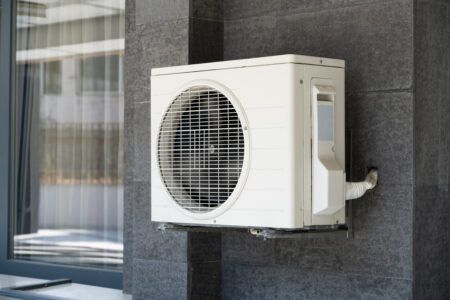With winter temperatures in Bountiful, UT often falling below freezing, it’s important to find the right heating solution for your home. The best options offer a seamless blend of reliability and efficiency so that homeowners aren’t constantly battling heating emergencies or paying small fortunes for cold-weather climate control. With heat pumps and traditional furnaces as the top options, read on to discover the benefits and drawbacks of each.
Heating Your Bountiful Home With a Heat Pump
Like central air conditioners, heat pumps have both indoor air handlers and outdoor condensers. During winter, air-source heat pumps extract heat from the outdoor air and move it inside. Throughout each heating cycle, they circulate pressurized refrigerant that drives the heat transfer process. Although they still rely on ducted air distribution systems, heat pumps are less likely to dry out indoor air than forced-air furnaces.
The Most Efficient in the Proper Environment
In the right conditions, heat pumps are easily the most efficient central HVAC equipment type available. The efficiency of gas-fired, oil-fired, and electric furnaces is measured by comparing the amount of fuel consumed to the amount of heat produced. Also known as annual fuel utilization efficiency (AFUE) ratings, these ratings additionally denote the amount of fuel that’s converted into harmful emissions due to incomplete combustion.
All electric furnaces have AFUE ratings of 100%. They produce just as much heat energy as they consume in electric energy, and they don’t produce carbon emissions. Some high-efficiency gas-fired furnaces convert as much as 98.5% of the fuel they consume into heat energy. With AFUE ratings of 98.5%, gas furnaces only turn about 1.5% of the gas they burn into carbon monoxide (CO) and other greenhouse emissions.
To compare, heat pumps can have efficiency levels of 400% or even higher. In the right operating conditions, they can produce four times as much heating and cooling energy as they consume in electric energy.
Heat Pumps Provide Year-Round Climate Control
One of the many benefits of choosing a heat pump as your primary heat source is the fact that it can also serve as your primary source of cooling. During the summertime, heat pumps are functionally identical to central air conditioners. They simply reverse the flow of their refrigerant and transfer warm air outside. With a properly rated heat pump, you’ll have less HVAC equipment to maintain, lower home cooling costs, and a significantly smaller carbon footprint.
Freezing Weather and Declining Heat Pump Performance
The biggest drawback of using a heat pump for heating is that its efficient performance is entirely dependent upon operating conditions. Air-source heat pumps are the most installed heat pump type in the nation. When outside temperatures dip too low, these units struggle to source enough outdoor heat to transfer indoors. They run longer and more frequent heating cycles, use more energy, and may experience problems with icing on their outdoor coils.
However, this doesn’t mean that you can’t use a heat pump for heating in Bountiful and still enjoy impressive levels of efficiency. You simply need to choose the right heat pump type for the demands of the local climate. Many entry-level heat pumps decline in performance when the outside temperature dips below 40 degrees Fahrenheit. They also become less efficient than even mid-efficiency gas furnaces when outside temperatures are as low as 25 degrees Fahrenheit. At this temperature, freezing coils become a frequent problem as well.
To compare, a high-performance or cold-weather heat pump can continue producing heat even when outside temperatures are as low as -5 degrees Fahrenheit. Moreover, they can do so while maintaining efficiency levels that match or exceed those of many high-efficiency furnaces. These heat pumps also have built-in features for mitigating icing problems within outdoor units such as base pan heaters.
Heating Your Home With a Furnace
In Utah, natural gas heating has long been the top choice. Although Utah isn’t ranked among the United States Department of Energy’s (DOE) top five natural gas producers, it has the fourth-highest number of natural gas and producing oil leases on federal lands, as per the United States Energy Information Administration (EIA). Utah has a robust natural gas infrastructure and the region’s winter weather is well-suited to this fuel type. Moreover, while other states are increasingly banning the use of natural gas-fired appliances, Utah has implemented a ban on stopping the use of natural gas and continues to allow residents to use it.
Compared to other combustible fuels, natural gas is clean burning. It also burns hotter. A natural gas furnace can produce heat as high as 140 degrees Fahrenheit or hotter. This allows these appliances to heat homes both quickly and evenly. In comparison, heat from electric heat pumps is between just 90 degrees and 92 degrees Fahrenheit. While certainly warmer than the average room, this is also much cooler than the human body temperature. Thus, although they’re as effective as furnaces, heat pumps don’t provide the rapid warmth and comfort that residents are often seeking.
Gas Heating vs. Electric Heating
It’s important to note that when choosing a furnace for heating, gas-fired models aren’t your only choice. Not only do all electric furnaces come with AFUE ratings of 100%, but none of these units pose the risk of carbon monoxide exposure. Given that they aren’t subjected to constant stress and exceedingly high temperatures of fuel combustion, electric furnaces also enjoy longer lifespans. For instance, while many natural gas furnaces last between 15 and 20 years, some electric furnaces have expected lifespans of 25 to 30 years.
Natural Gas Is Cheaper Than Electricity
People who rely on natural gas often complain about natural gas prices. As with all things in recent years, natural gas costs quite a bit more than it once did. However, natural gas prices are both lower than local electricity rates and far less volatile. Thus, while you might use more natural gas to produce the necessary amount of heat for your home, you’ll pay a lot more to use less electricity and achieve the same results.
Exploring Your Options in Hybrid Heating Systems
Rather than choosing between heat pumps and gas furnaces, some homeowners have opted for both. Also known as hybrid heating systems or dual-fuel heating systems, these combinations offer the best of both worlds. With a dual-fuel heating system, you can heat your home with a heat pump in late fall and early winter or when temperatures warm up a bit at the start of spring. When below-freezing temperatures arrive, your HVAC system will draw and distribute heat from your furnace instead.
A high-performance heat pump will provide year-round temperature control. A dual-fuel heating system will do the same but may offer superior performance in extreme weather conditions. With more flexibility, you can also use a dual-fuel heating system to limit the financial effects of changing gas prices and electricity rates.
We keep residents of Bountiful, UT and the surrounding cities on the cutting-edge of HVAC technology with top-quality heating and cooling equipment. We offer outstanding furnace, AC, and heat pump services. We also provide advanced indoor air quality improvements, plumbing services, and preventative maintenance plans. For help choosing the right heater for your home, contact Blue Best Plumbing, Heating, Air, Generators now.








